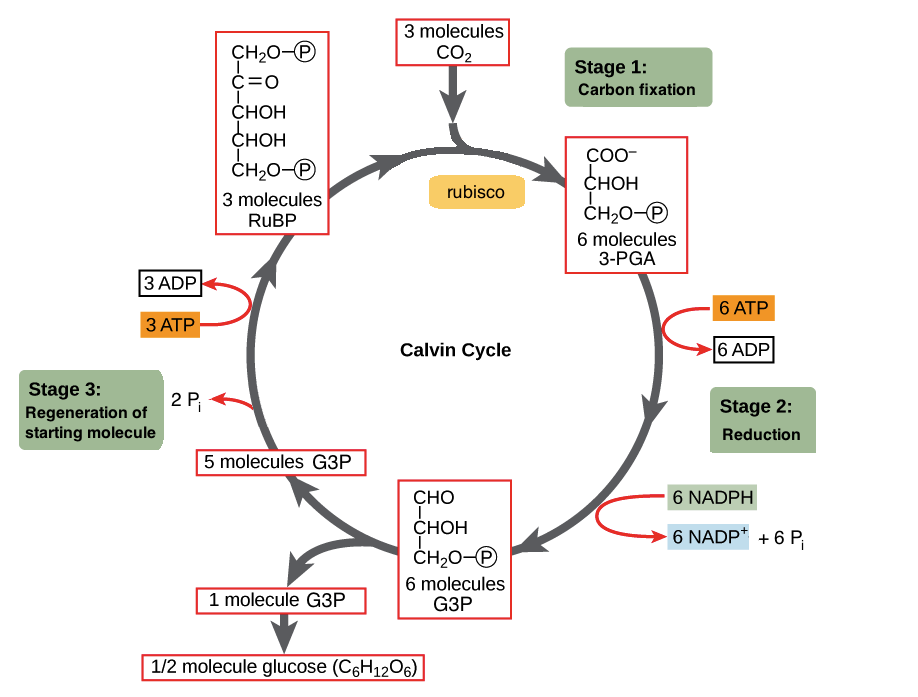1
Question
Describe the process of C3 path of carbon fixation. How many CO2 molecules are needed for operation of its one cycle?
Open in App
Solution

C3 cycle was discovered by M Calvin. It is the major pathway for the fixation of carbon dioxide in green plants. After the fixation of carbon dioxide, the first stable compound formed is 3-carbon Phosphoglyceric Acid (PGA) . Hence, it is called the C3 pathway.Calvin cycle has three stages:1. Carboxylation of RuBPIn this step, there is fixation of atmospheric CO2 into a stable organic compound 3-Phosphoglyceric Acid (3PGA) with the help of enzyme RuBP, carboxylase-oxygenase or RuBisCo. 2. Reduction of CO2The 3-C PGA then undergoes reduction with the help of the assimilatory power to form 3-C Phosphoglyceraldehyde (PGAL). NADPH2 provides the hydrogen and ATP supplies energy for reduction. The reaction is catalyzed by the enzyme triosephosphate dehydrogenase. Some molecules of PGAL are converted into another triosephosphate called Dihydroxy Acetone Phosphate (DHAP) in the presence of enzyme phosphotriose isomerase.The formation of sugars (end products of photosynthesis), the 3-C triose phosphates (i.e. PGAL and DHAP) form 6-C hexose sugar- fructose-1,6-bisphosphate in the presence of enzyme aldolase. Fructose biphosphate is then diphosphorylated first to fructose monophosphate and then to fructose in the presence of enzyme phosphatase. The hexose sugar may be further converted to Sucrose or to starch and is stored in starch cells.3. Regeneration of RuBPThe 5-C RuBP is constantly required for the fixation of CO2 in the Calvin cycle. It is regenerated through another chain of reactions. Some molecules of triosephosphates and fructose monophosphates are used from the Calvin cycle for the formation of RuBP to be used again to combine with CO2.
The net reaction of Calvin cycle can be represented as 6RuBP + 6CO2 + 18ATP + 12NADPH ----> 6RuBP + C6H12O6 + 18ADP + 12NADPH+ + 18Pi.
One molecule of CO2 is fixed in one turn of C3 cycle. Thus 6 turns of the cycle will be required to fix 6 molecules of CO2 i.e. to form C6H12O6 (glucose).

C3 cycle was discovered by M Calvin. It is the major pathway for the fixation of carbon dioxide in green plants. After the fixation of carbon dioxide, the first stable compound formed is 3-carbon Phosphoglyceric Acid (PGA) . Hence, it is called the C3 pathway.
Calvin cycle has three stages:
1. Carboxylation of RuBP
In this step, there is fixation of atmospheric CO2 into a stable organic compound 3-Phosphoglyceric Acid (3PGA) with the help of enzyme RuBP, carboxylase-oxygenase or RuBisCo.
2. Reduction of CO2
The 3-C PGA then undergoes reduction with the help of the assimilatory power to form 3-C Phosphoglyceraldehyde (PGAL). NADPH2 provides the hydrogen and ATP supplies energy for reduction. The reaction is catalyzed by the enzyme triosephosphate dehydrogenase. Some molecules of PGAL are converted into another triosephosphate called Dihydroxy Acetone Phosphate (DHAP) in the presence of enzyme phosphotriose isomerase.
The formation of sugars (end products of photosynthesis), the 3-C triose phosphates (i.e. PGAL and DHAP) form 6-C hexose sugar- fructose-1,6-bisphosphate in the presence of enzyme aldolase. Fructose biphosphate is then diphosphorylated first to fructose monophosphate and then to fructose in the presence of enzyme phosphatase. The hexose sugar may be further converted to Sucrose or to starch and is stored in starch cells.
3. Regeneration of RuBP
The 5-C RuBP is constantly required for the fixation of CO2 in the Calvin cycle. It is regenerated through another chain of reactions. Some molecules of triosephosphates and fructose monophosphates are used from the Calvin cycle for the formation of RuBP to be used again to combine with CO2.
The net reaction of Calvin cycle can be represented as
6RuBP + 6CO2 + 18ATP + 12NADPH ----> 6RuBP + C6H12O6 + 18ADP + 12NADPH+ + 18Pi.
One molecule of CO2 is fixed in one turn of C3 cycle. Thus 6 turns of the cycle will be required to fix 6 molecules of CO2 i.e. to form C6H12O6 (glucose).
Suggest Corrections
0
View More
Join BYJU'S Learning Program
Join BYJU'S Learning Program
